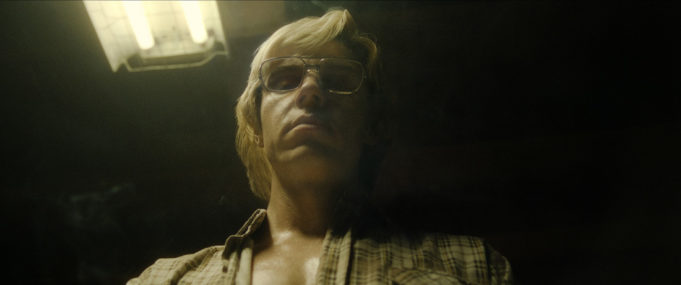What idiot executive told Netflix to title its dramatic series Dahmer — Monster: The Jeffrey Dahmer Story? One-third of the words would have told us what the show is about. The 10-part miniseries, which has been the streaming service’s biggest hit ever, has been the subject of controversy for more than a few reasons. It aims to take the focus off the serial killer and put it on his victims, and at its intermittent best, that’s what it achieves. However, showrunners Ryan Murphy and Ian Brennan (who previously made a series about the serial killer who murdered Gianni Versace) are too undisciplined to stay on task, though they manage to expose a few problems with the entire genre of true crime itself.
The first episode of Dahmer, “Bad Meat,” is a nearly perfect piece of television, focusing on Tracy Edwards (Shaun J. Brown), the Black man who meets Jeff (Evan Peters) at a gay club in Milwaukee in 1991, goes home with him, realizes what this bespectacled white man is, escapes, and brings back the police. The director of this episode, Carl Franklin, has been executing slow-burn thrills ever since he was making movies like One False Move and Devil in a Blue Dress in the 1990s, and he squeezes every last drop of panic out of the situation. The stagey 2002 film Dahmer takes up this same incident and stars a pre-fame Jeremy Renner, yet “Bad Meat” is far more terrifying as it concentrates on Tracy’s panicked efforts to do whatever he needs to do — including a sexy striptease — to placate the killer until a chance to break free presents itself. Jeff lays his head on Tracy’s bare chest and says, “I want to hear your heartbeat. I’m going to eat it,” and Tracy merely strokes Jeff’s hair in response. Even after Tracy manages to flee the building and get to the street, he’s not necessarily safer in the hands of the police, who have a history of killing unarmed Black men. The strength of this self-contained episode is likely what made this show such a hit, and it leaves you wondering why it’s the only episode that Franklin directed.
Movies and TV shows about real and fictional serial killers often present us with women being victimized, so Dahmer puts some weight on the other side of the scale by showing us how men can be preyed on, too. Most of Dahmer’s victims were men of color, a fact that was largely glossed over when the story broke in the early 1990s. Whether or not the cannibal serial killer was motivated by race, his victims being largely Black and gay was a factor in why he was allowed to get away with his murders for so long, and stating as much in a well-crafted TV drama carries more impact than doing so in some criminology study.
There’s much else to recommend the show. Evan Peters is as frightening as you’ve heard, and if you saw him as the wisecracking best friend in Kick-Ass, you won’t believe it’s the same actor. Episode 6, “Silenced,” is a moving testament to Tony Hughes (Rodney Burford), Dahmer’s gay and deaf victim who harbored dreams of becoming a fashion model. The following episode, “Cassandra,” concentrates on Glenda Cleveland (Niecy Nash), the neighbor who repeatedly alerted the police to the strange noises and smells coming from Jeff’s place only to watch the cops hand one of his escaped victims back to him. (This show is red meat for the ACAB crowd.)
The problem is, these are isolated instances. The show has one outright bit of sensationalism when it shows us John Wayne Gacy (Dominic Burgess) murdering one of his victims in Chicago while wearing his full clown makeup. That aside, despite Dahmer’s attempts to avoid focusing on Jeff, it can’t look away. Maybe there’s no treatment that could have avoided glamorizing him, and maybe there’s a flaw in human nature that makes us more fascinated by the monster than by his victims. (I mean, can you name everyone that Freddy Krueger kills in the Nightmare on Elm Street movies?)
What’s sure is this: There’s too much Dahmer in Dahmer. The show concludes that it’s fruitless trying to isolate what made him a monster, so why does it spend so much time on his methods and his relations with his family? Murphy and Brennan have only occasionally been sensitive to their characters, particularly to the ones of color, and the plethora of other projects they’re working on can’t have helped them think through some of their work’s issues. (Speaking of sensitivity, consulting with the families of Dahmer’s victims might or might not have improved the final product, but it would have been nice to do.) If the show results in the city of Milwaukee building a memorial to the man’s victims like Glenda Cleveland has wanted, then that’s great. However, the show’s limitations prevent it from being that memorial.












